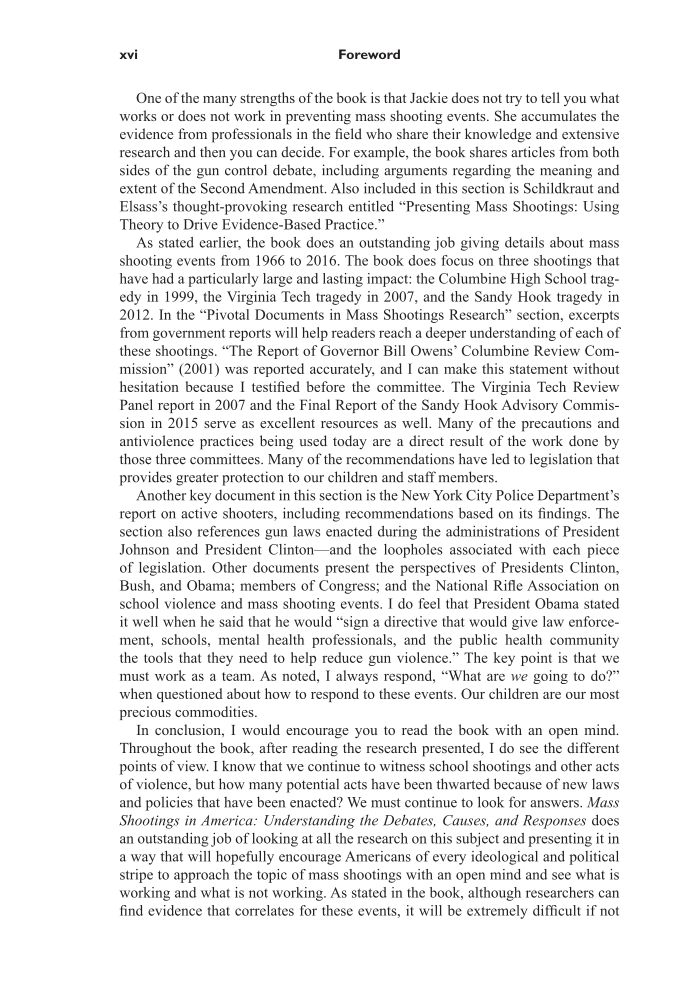xvi Foreword One of the many strengths of the book is that Jackie does not try to tell you what works or does not work in preventing mass shooting events. She accumulates the evidence from professionals in the field who share their knowledge and extensive research and then you can decide. For example, the book shares articles from both sides of the gun control debate, including arguments regarding the meaning and extent of the Second Amendment. Also included in this section is Schildkraut and Elsass’s thought-provoking research entitled “Presenting Mass Shootings: Using Theory to Drive Evidence-Based Practice.” As stated earlier, the book does an outstanding job giving details about mass shooting events from 1966 to 2016. The book does focus on three shootings that have had a particularly large and lasting impact: the Columbine High School trag- edy in 1999, the Virginia Tech tragedy in 2007, and the Sandy Hook tragedy in 2012. In the “Pivotal Documents in Mass Shootings Research” section, excerpts from government reports will help readers reach a deeper understanding of each of these shootings. “The Report of Governor Bill Owens’ Columbine Review Com- mission” (2001) was reported accurately, and I can make this statement without hesitation because I testified before the committee. The Virginia Tech Review Panel report in 2007 and the Final Report of the Sandy Hook Advisory Commis- sion in 2015 serve as excellent resources as well. Many of the precautions and antiviolence practices being used today are a direct result of the work done by those three committees. Many of the recommendations have led to legislation that provides greater protection to our children and staff members. Another key document in this section is the New York City Police Department’s report on active shooters, including recommendations based on its findings. The section also references gun laws enacted during the administrations of President Johnson and President Clinton—and the loopholes associated with each piece of legislation. Other documents present the perspectives of Presidents Clinton, Bush, and Obama members of Congress and the National Rifle Association on school violence and mass shooting events. I do feel that President Obama stated it well when he said that he would “sign a directive that would give law enforce- ment, schools, mental health professionals, and the public health community the tools that they need to help reduce gun violence.” The key point is that we must work as a team. As noted, I always respond, “What are we going to do?” when questioned about how to respond to these events. Our children are our most precious commodities. In conclusion, I would encourage you to read the book with an open mind. Throughout the book, after reading the research presented, I do see the different points of view. I know that we continue to witness school shootings and other acts of violence, but how many potential acts have been thwarted because of new laws and policies that have been enacted? We must continue to look for answers. Mass Shootings in America: Understanding the Debates, Causes, and Responses does an outstanding job of looking at all the research on this subject and presenting it in a way that will hopefully encourage Americans of every ideological and political stripe to approach the topic of mass shootings with an open mind and see what is working and what is not working. As stated in the book, although researchers can find evidence that correlates for these events, it will be extremely difficult if not
Document Details My Account Print multiple pages
Print
You have printed 0 times in the last 24 hours.
Your print count will reset on at .
You may print 0 more time(s) before then.
You may print a maximum of 0 pages at a time.















































































































































































































































































































































































